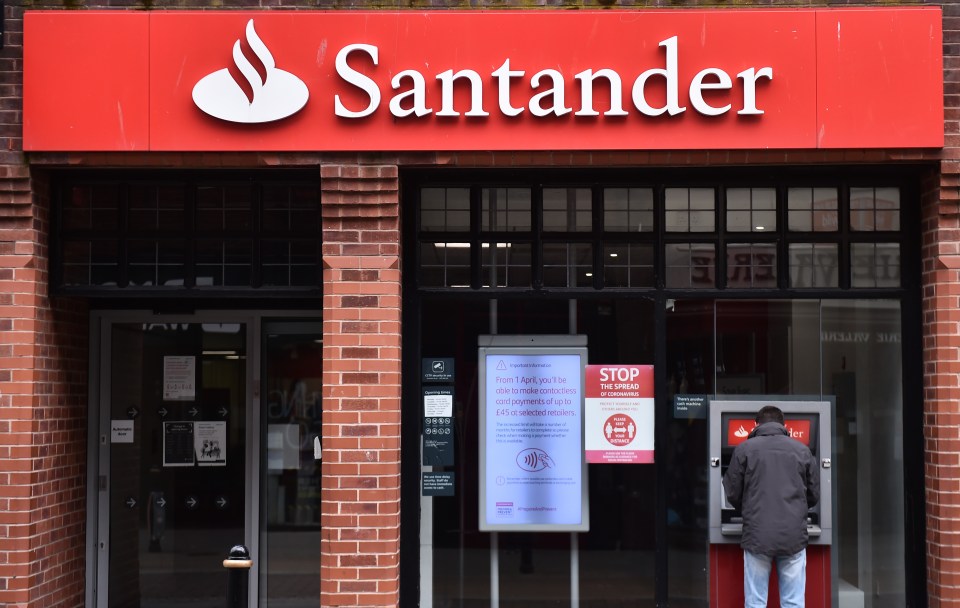SANTANDER has made a huge change to almost a dozen accounts this week in a blow to thousands of savers.
The high street giant cut the interest rates on 11 of its savings accounts on August 11.
It comes after the Bank of England voted to lower its base rate from 4.5% to 4.25% in May.
The decision came as a relief to millions of homeowners on variable rate mortgages, which rise and fall in line with the base rate.
But the move often means smaller returns for savers, as when the base rate falls, interest rates on savings often do too.
As a result, Santander has cut the interest rates on almost a dozen accounts this week.
Read more on bank accounts
Among the accounts affected are the Easy Access Saver (Issue 26 and 27), which have seen their interest rates drop from 1.3% to 1.2%.
If you had paid £2,000 into this account previously you would have £26 after one year.
But now the rate has dropped to 1.2% you will earn £24 – a difference of £2.
Meanwhile, several Isa accounts have also had their rates slashed.
Among them is the Easy Access Isa (Issue 22 and 23) which has also seen its rate fall from 1.3% to 1.2%.
The interest rate on the Help to Buy Isa will also be cut from 2.45% to 2.35%.
The change means the amount of interest you would earn on a £2,000 deposit after one year would fall from £49 to £47.
Children’s accounts have also been hit by the interest rate changes.
The rate on a Junior Isa has been cut from 2.8% to 2.7%.
Plus, the interest rate on a Flexible Saver for Kids is now 1.95%, down from 2.05%.
What types of savings accounts are available?
THERE are four types of savings accounts: fixed, notice, easy access, and regular savers.
Separately, there are ISAs, or individual savings accounts, which allow individuals to save up to £20,000 a year tax-free.
But we’ve rounded up the main types of conventional savings accounts below.
FIXED-RATE
A fixed-rate savings account or fixed-rate bond offers some of the highest interest rates but comes at the cost of being unable to withdraw your cash within the agreed term.
This means that your money is locked in, so even if interest rates increase you are unable to move your money and switch to a better account.
Some providers give the option to withdraw, but it comes with a hefty fee.
NOTICE
Notice accounts offer slightly lower rates in exchange for more flexibility when accessing your cash.
These accounts don’t lock your cash away for as long as a typical fixed bond account.
You’ll need to give advance notice to your bank – up to 180 days in some cases – before you can make a withdrawal or you’ll lose the interest.
EASY-ACCESS
An easy-access account does what it says on the tin and usually allows unlimited cash withdrawals.
These accounts tend to offer lower returns, but they are a good option if you want the freedom to move your money without being charged a penalty fee.
REGULAR SAVER
These accounts pay some of the best returns as long as you pay in a set amount each month.
You’ll usually need to hold a current account with providers to access the best rates.
However, if you have a lot of money to save, these accounts often come with monthly deposit limits.
The interest rate on an Inheritance Isa has been slashed from 2.85% to 2.7% while the First Home Saver has seen the return it offers savers drop from 2.45% to 2.35%.
All of these accounts have variable interest rates, which means the rate can go up or down.
Savers impacted by the changes should have been contacted in June.
Fortunately, the major bank still offers returns of up to 5% on its Regular Saver account.
A spokesperson for the bank said: “We are committed to delivering value for our savings customers and offer a range of competitive savings products.”
On average savers have around £9,633 squirrelled away, according to online savings platform Raisin, which means it is vital to make sure you are getting the best return.
Always compare different accounts to ensure you are getting the most for your money.
What are the best accounts on offer?
If you want to be able to access your cash at any time then you should go for an easy-access saver account.
These accounts usually allow you to withdraw money when you need to without a penalty.
But always read the small print as some of these accounts may only allow you to pay in a certain amount or make a set number of withdrawals or the rate will drop.
The best easy-access account on offer comes from Chase and has an interest rate of 5%.
This means if you saved £1,000 into this account you would earn £50 a year in interest.
Meanwhile, Cahoot offers savers a return of 4.55% on savings of £1 or more.
If you don’t need access to your money right away then a notice account could be a great option.
These accounts offer top rates but still let you access your money more easily than a fixed-rate bond.
Stafford Building Society’s 180 day account offers a return of 4.61% on balances of more than £5,000.
Meanwhile, Plum’s 95-day notice pocket pays 4.58% on £1 or more.
How can I find the best savings rates?
WITH your current savings rates in mind, don’t waste time looking at individual banking sites to compare rates – it’ll take you an eternity.
Research price comparison websites such as Compare the Market, Go.Compare and MoneySupermarket.
These will help you save you time and show you the best rates available.
They also let you tailor your searches to an account type that suits you.
As a benchmark, you’ll want to consider any account that currently pays more interest than the current level of inflation – 3.4%.
It’s always wise to have some money stashed inside an easy-access savings account to ensure you have quick access to cash to deal with any emergencies like a boiler repair, for example.
If you’re saving for a long-term goal, then consider locking some of your savings inside a fixed bond, as these usually come with the highest savings rates.
Do you have a money problem that needs sorting? Get in touch by emailing money-sm@news.co.uk.
Plus, you can join our Sun Money Chats and Tips Facebook group to share your tips and stories













